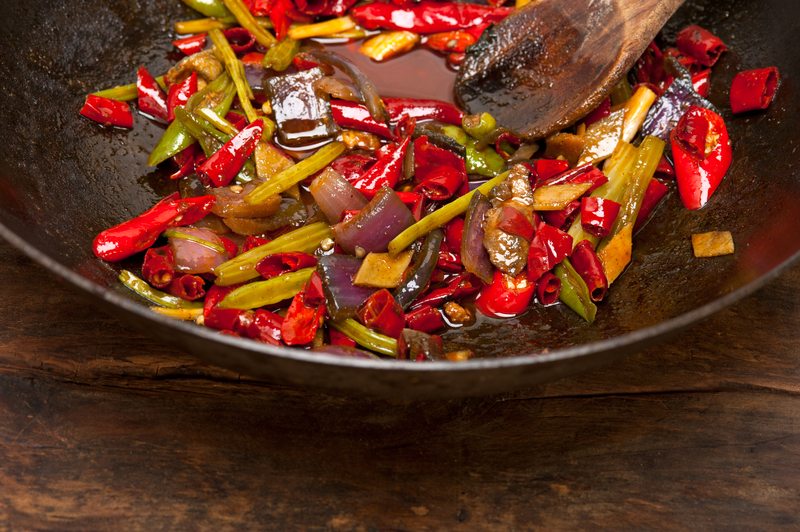Properly Seasoning a Wok – Method 2

Properly Seasoning a Wok – Method 2
By Norm Huffnagle
If you’ve never used a wok before, you’re definitely in for a treat. Woks can be great fun and make exciting conversation pieces. Woks, like your Grandmother’s cast iron Dutch oven, will last for years, take lots of abuse, and cook everything under the sun. Woks come in two basic types: non-stick and conventional. I prefer conventional: most recipes have you ‘push the contents up onto the walls of the wok’, something that’s impossible to do with a non-stick – the contents continue to slide back down to the bottom. The conventional woks are either ribbed that tend to hold the contents, or ‘hand hammered’, where almost imperceptible ‘dents’ from the hammering process secure the contents to the sides. Both woks are good. I personally prefer ‘hand hammered’. Get a wok with a “Steam Dome”. You’ll need it!
Whichever wok you select, if it’s non-stick, it doesn’t need seasoning. The conventional woks do. The seasoning not only prepares the metal’s surface by sealing the metal’s pores, it actually makes the wok non-stick! Like a well-seasoned cast iron pan, food won’t stick to a well-seasoned wok.
When you buy a wok, it probably will come with a set of instructions that tell you how to care for your new purchase. It will also give you a procedure to season your wok. Be sure to follow the instructions. But here is my alternative “Oil and Salt Seasoning Method” that takes less time that the “standard” method to create a well-seasoned wok.
Warning: Don’t try this to ‘season’ a non-stick wok: you’ll just ruin the wok.
Oil and Salt Seasoning Method
- Scour the inside of a new carbon steel wok with warm soapy water and a scouring pad to remove all traces of the oil used in the wok’s manufacture. Rinse and dry well.
- Place the cleaned wok on a stove burner and heat until just touch warm to remove any residual water.
- Using a suitable vegetable cooking oil, like peanut, avocado, olive, or grapeseed oil, coat the interior of the wok. Work a coat of common table salt over the oiled surface, making sure that all the oil is covered with salt. I use a spoon to pour salt over the oily surface.
- Place the wok on a stove burner and turn the burner on high. Leave on burner for 15 minutes. There will be a considerable amount of smoke as the volatiles in the oil burn off.
- When the wok stops smoking, remove wok from burner and let cool completely. The inside of the wok will be black.
- Rinse out the salt using hot water and a smooth sponge.
- Wipe dry and place on a burner. Heat until touch warm.
- Wipe a thin coat of oil onto the inside of the wok. Wipe away excess with a paper towel.
- You’re done!
- Now, every time you use the wok, wipe a thin coat of cooking oil over the inside surface before heating the wok. Then add what oil the recipe calls for when the wok’s heated.
- The more the wok is used, the more the inside will continue to blacken. That’s the “non-stick” coating you want.
- Never scour a wok’s insides with soap and a pad.
- Use only hot water and a bamboo whisk to clean the wok.
- Always wipe your wok dry and add a coating of oil after rinsing.
Norm Huffnagle enjoys sharing exotic recipes with friends and family. Although more of a ‘gourmand’ than a ‘gourmet’, he does ‘dabble’ in that arcane art of unconventional cooking to the point that he has actually been invited back to do repeat performances. Norm specializes in ancient Chinese dishes, various flavors of Chilis, contemporary Mediterranean cuisine, and Special Occasion cookbooks. Check out his latest Chinese cookbook, “Chinese if You Please: Delicious, Simple, Fresh Wok and Stir-fry from Master Xia Zhou Chiang “, available on Amazon/kindle. The link is: https://amzn.com/B015BUHO9I.
Blow your mind: Peruse my avatar’s Author Page on Amazon to see what else is available: http://www.amazon.com/-/e/B014LGT3XI
Article Source: http://EzineArticles.com/expert/Norm_Huffnagle/721035
http://EzineArticles.com/?Properly-Seasoning-a-Wok—Method-2&id=9832152







